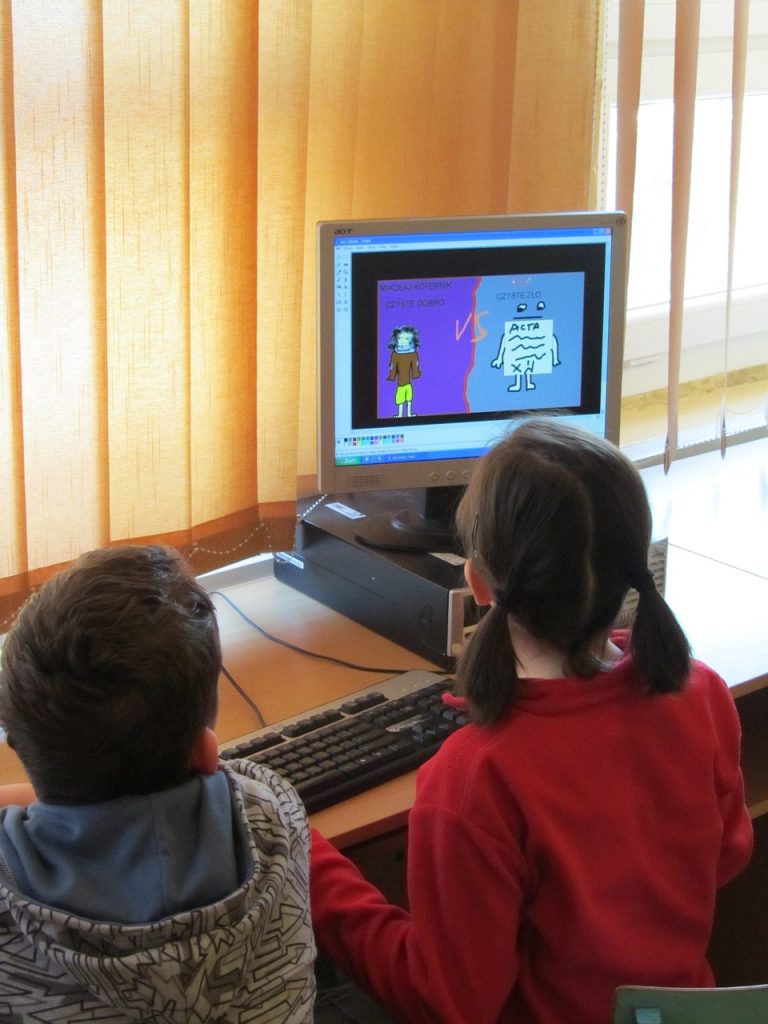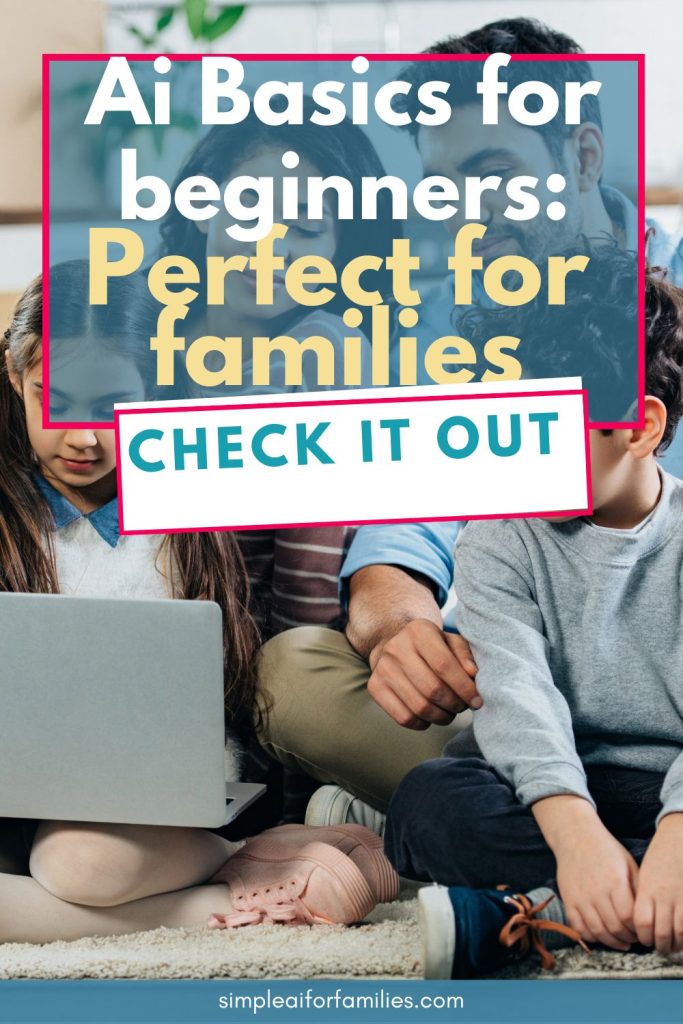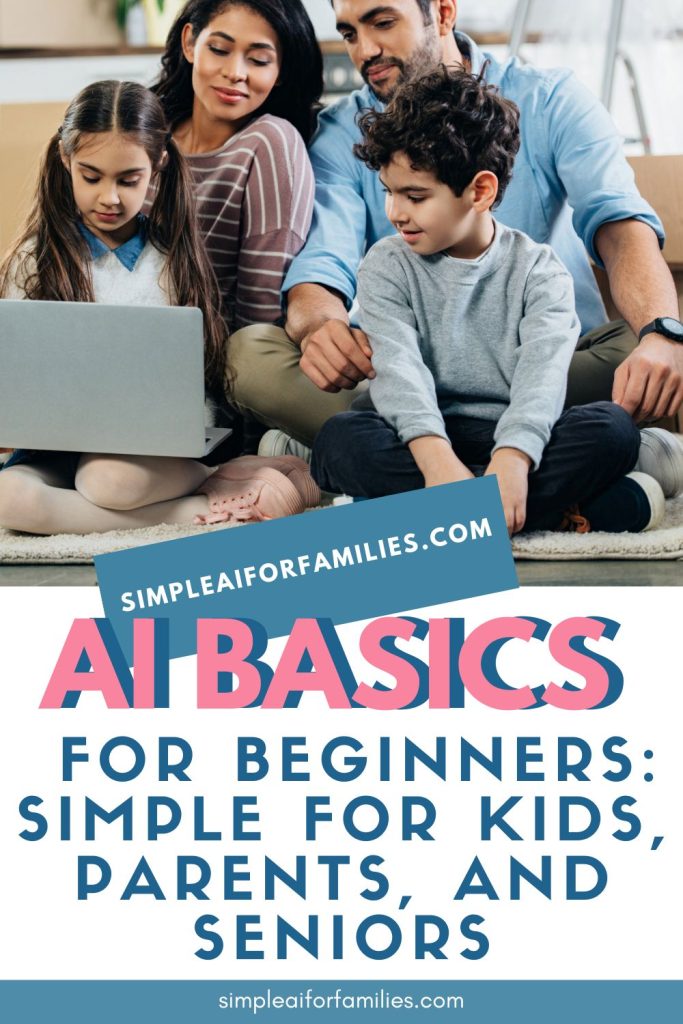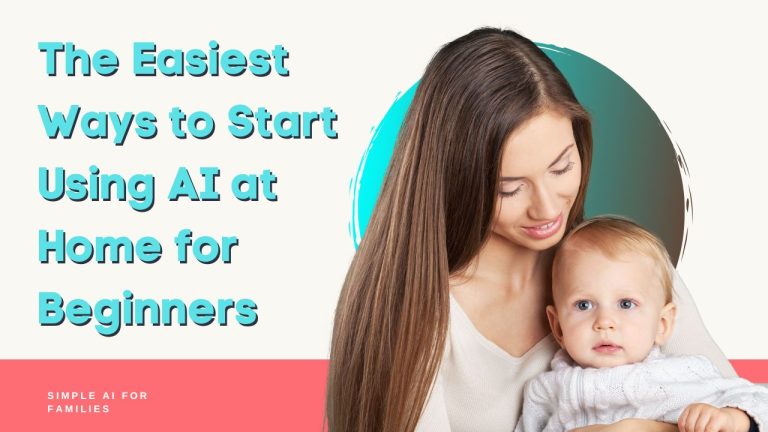AI Basics for Beginners: Simple for Kids, Parents, and Seniors
Let’s break down Ai basics for beginners and families.

Artificial intelligence (AI) might sound complicated, but it’s simpler than you think. It’s the technology behind voice assistants like Alexa, the recommendations on Netflix, and even the face filters kids love on apps.
For beginners, understanding AI starts with knowing how it’s already part of everyday life. Whether you’re a parent curious about what your kids are learning, a senior wanting to explore new tech, or a student eager to dive into this topic, this guide will break it all down. You’ll discover how AI works, its basic concepts, and how it can inspire creativity and problem-solving for all ages.

What is Artificial Intelligence?
Artificial intelligence (AI) is a branch of computer science that focuses on designing machines capable of simulating human intelligence. In simpler terms, it’s programming computers to handle tasks usually done by people—like solving problems, making decisions, or even recognizing faces in photographs.
AI powers voice assistants like Siri and Alexa, helps cars drive themselves, and even customizes what shows up on your child’s YouTube recommendations. It works quietly behind the scenes in everyday tech, making life easier in ways you might not even notice.
Let’s break down the key parts of AI so that everyone—parents, kids, and seniors—can better understand this exciting technology.
Types of Artificial Intelligence
There are two main types of AI that you’ll hear about: Narrow AI and General AI. These terms describe how sophisticated or flexible an AI system is.
- Narrow AI: This is the type of AI we use today, and it’s designed to handle specific tasks. For example, when you ask Alexa to set a reminder or when your smartphone predicts what word you want to type next, that’s narrow AI at work. It’s excellent at doing one thing but doesn’t “think” like a person or adapt beyond its programming.
- General AI: Imagine a robot that not only vacuums your home but can also cook dinner, play chess, and provide emotional support—this is the dream of General AI. It would function much like a human mind, handling multiple tasks, adapting to new situations, and even showing creativity. While this idea is fascinating, it’s still in the realm of science fiction for now.
To simplify, think of Narrow AI like a flashlight that focuses on one task—it’s limited but effective. General AI, on the other hand, would act like the sun, capable of shining in many directions and adapting to different situations. Right now, we’re only holding the flashlight.
How AI Mimics Human Intelligence
AI is designed to mimic how humans think. But how does it do that? The “brain” behind any AI is a computer algorithm—a detailed list of instructions that tells the machine how to perform a task. Here’s how it mirrors key human abilities:

- Learning: Humans learn by observing and practicing, and so does AI. Think of how kids learn to recognize animals: they see a dog labeled as “dog” multiple times until they figure out how to identify one. Similarly, AI uses something called “machine learning.” It looks at huge amounts of data—like photos of dogs—to figure out patterns and make predictions.
- Problem-Solving: Ever asked Google Maps for directions? AI analyzes endless amounts of traffic data to guide you on the quickest route. Just like solving a puzzle, AI calculates possibilities and chooses the best solution.
- Decision-Making: AI systems can evaluate information to make decisions, often faster than humans. For example, your bank might use AI to detect unusual activity on your account and decide to flag it as fraud. These decisions are based on algorithms trained to assess specific scenarios.
In essence, AI doesn’t “think” the way people do—it follows rules programmed into it. Yet, it can imitate certain human behaviors well enough to make life a whole lot easier (or more fun, like those face-swap apps everyone enjoys!).
When you understand these basic concepts, AI stops feeling mysterious and starts to feel like an incredible tool that anyone—including kids, parents, and grandparents—can explore confidently.
Why Learn AI Basics?
Artificial intelligence (AI) is no longer a futuristic concept. It’s a part of the world we interact with daily, from checking directions on apps to receiving curated shopping recommendations. Understanding its basics is like learning the alphabet of tomorrow’s world—it sets the foundation for grasping exciting technological breakthroughs shaping our lives and careers. Let’s break it down further.
Applications of AI in Everyday Life
AI isn’t just for scientists or tech whizzes—it’s something most of us use without even realizing. Recognizing AI in everyday activities can inspire anyone, from curious kids to tech-savvy grandparents.
- Navigation Apps: Tools like Google Maps or Waze rely on AI to predict the fastest routes, identify traffic conditions, and even spot accidents. Ever wondered how they know it will take “15 minutes to get there”? That’s AI crunching real-time data.
- Personalized Shopping: When Amazon, Netflix, or Spotify recommend products, shows, or songs and you think, “That’s exactly what I wanted!”—that’s AI at work. It learns your preferences to deliver suggestions tailored just for you.
- Language Translation Tools: Apps like Google Translate use AI to interpret and translate languages seamlessly. They recognize words and context, making travel or language learning more accessible.
- Voice Assistants: Whether it’s Alexa answering a question or Siri setting a timer, these digital helpers depend on AI to understand natural speech patterns and provide instant responses.
- Bank Fraud Detection: Ever received a bank notification about potentially fraudulent charges? AI analyzes patterns in your spending habits to flag anything out of the ordinary.
AI is woven into the fabric of daily life, from helping us navigate cities to making online shopping and communication easier. Learning its basics makes these tools feel less like magic and more like something anyone can understand.
Future Career Opportunities
AI isn’t just transforming our personal lives—it’s reshaping the job market. For kids dreaming big or working adults considering a career shift, knowing AI basics can open doors to high-demand, high-paying careers.
- Job Roles on the Rise: Careers such as AI engineers, data scientists, and machine learning specialists are booming. These roles involve creating algorithms, analyzing data, and designing systems that improve over time—skills in high demand across industries.
- Opportunities for All Ages: You don’t need to be a tech guru to benefit from AI skills. For kids, learning AI basics today could mean future opportunities in creative fields, like designing AI-powered gaming experiences. For adults, basic AI literacy—like understanding how data shapes business decisions—can make you an invaluable team member at any company.
- Non-Tech Jobs Embracing AI: From marketing to healthcare, basic AI knowledge helps professionals use AI tools effectively. Doctors use AI to diagnose diseases, marketers enhance strategies with AI-powered analytics, and teachers explore innovative ways to educate students using smart tools.
- Ease of Access: Many online resources make learning AI basics simple and approachable. Platforms offer tutorials for beginners, aimed at breaking complicated concepts into manageable lessons. No expensive degree required!
Think of it like this: AI is a bridge connecting today’s knowledge to tomorrow’s opportunities. By learning its basics, you’re strengthening that bridge—for yourself, your kids, or anyone eager to stay ahead in an AI-driven world.
AI Basics for Beginners

Artificial intelligence doesn’t need to feel overwhelming. With the right tools and fun hands-on activities, anyone can begin exploring AI, no matter their age. Whether you’re an elementary school student, a busy parent, or a curious grandparent, this section offers practical resources and ideas to help beginners start their AI journey with ease.
Tools and Resources for Beginners
Getting started with AI is easier than it looks, especially when there are so many user-friendly platforms designed for beginners. Here are some great tools and resources available for everyone from kids to adults:
- Scratch: Designed for kids but fun for all ages, Scratch is a block-based coding tool that simplifies programming concepts. Some AI extensions allow learners to experiment with machine learning features.
- Python Tutorials for Beginners: Python is one of the most approachable programming languages for AI. Platforms like Codecademy, W3Schools, or free YouTube tutorials make learning Python highly accessible.
- Google AI Essentials: Perfect for parents or seniors looking to understand AI basics. Google’s self-paced online course includes hands-on exercises, videos from experts, and a certificate of completion.
- Teachable Machine by Google: An intuitive website where users can teach a machine to recognize images, sounds, or poses. It’s as easy as uploading photos and letting the program do the rest!
- Machine Learning for Kids: A dedicated tool that combines Scratch with practical exercises for teaching children how machine learning works in real-world scenarios.
- Khan Academy AI Concepts: A trusted educational platform offering short, straightforward lessons on how AI applies to problems like image recognition or personalized recommendations.
Free resources, like Coursera’s “AI for Everyone” by Andrew Ng or MIT’s “AI Basics,” also provide beginner-friendly materials that bring complex topics into everyday language. Spend a weekend exploring one, and you’ll feel a lot more confident.
Simple AI Projects for Families
Learning AI doesn’t have to feel like homework. By turning it into fun, interactive projects, families can explore this exciting field together. Here are a few beginner-friendly project ideas that can be done at home:
- Create a Chatbot:
- Use free programs like Dialogflow or Scratch to design a simple chatbot.
- Teach your bot to answer basic family questions or respond to fun phrases like, “What’s for dinner?” It’s a great way to practice logic and communication.
- Build a Virtual Pet:
- Combine Scratch or Python programming with creative thinking to create a pet that “responds” to commands (e.g., “feed me,” “play with me”).
- Reinforce concepts like cause and effect while adding a fun, digital twist to classic toys like Tamagotchi.
- Image or Object Recognition:
- Use Google’s Teachable Machine to make a mini AI tool that can recognize different family members’ faces, favorite objects, or even pets.
- Share laughs as you test its accuracy and learn how AI identifies visual patterns.
- AI Music Maker:
- Experiment with AI-powered music apps like Amper Music or Magenta Studio. Let each family member create their own song using the platform’s intuitive tools.
- Discuss how AI “learns” to compose music and draw connections to real-life creative activities.
- Language Learning Buddy:
- Pair apps like Google Translate with a “fun quiz” twist. Ask the AI to translate family words or phrases into different languages to learn together.
- This sparks curiosity while introducing the idea of AI in translation technologies.
Turn these projects into bonding moments by involving the entire family. Discuss questions like, “How do you think the AI learned that?” or “What other problems could this technology solve?” These activities create not only fun memories but also deepen everyone’s understanding of artificial intelligence basics.

Making AI Accessible for All Ages
Artificial intelligence (AI) isn’t just for tech experts—it’s a tool everyone can use. From kids learning through interactive games to seniors exploring voice assistants, AI has something for all ages. Making AI more accessible can enhance learning, simplify daily tasks, and even build new skills across generations. Here are some approachable ways AI connects with kids, parents, and seniors.
AI for Kids: Learning through Play
Interactive learning tools like games and puzzles bring AI to life for children. These tools don’t just teach the technical side of AI but also encourage creativity and problem-solving. Curious how kids might start? It’s easier than you think.
- AI-Powered Games: Platforms such as “Lightbot” or “Machine Learning for Kids” use games to explain core AI ideas. These games teach basic coding, how machines “learn,” and challenge kids to solve puzzles step by step.
- Robot Toys: Products like Cozmo or Botley introduce AI by letting kids program simple actions or explore how robots “think.” For instance, a robot pet might follow commands, helping kids understand cause and effect.
Engaging kids with such tools is like sneaking vegetables into their favorite meal—they’re learning without even noticing! It’s all about fun and exploration, sparking curiosity that lays the groundwork for future learning.

Photo by Pavel Danilyuk
AI for Parents: Empowering Productivity
Life is busy, and parents are always juggling multiple responsibilities. AI tools can make day-to-day living more manageable by taking over repetitive tasks or offering timely solutions.
- Time Management Apps: Tools like Todoist or Google Calendar use AI to create smart schedules. They prioritize tasks based on deadlines and even send gentle reminders.
- Meal Planners: AI-powered apps like Mealime suggest customizable weekly menus based on your family’s preferences, grocery list integration, and even budget.
- Virtual Tutors: For parents who homeschool or want additional learning aids for their children, AI programs like Khan Academy help simplify tricky subjects.
Parents are already superheroes, but AI gives them a little extra power. Imagine an assistant that never sleeps, ready to help whenever you need it!
AI for Seniors: Simplifying Daily Life
AI isn’t intimidating—it’s a companion that makes life easier, especially for seniors. With user-friendly tools like voice assistants and personalized apps, interacting with technology has never been more approachable.
- Voice Assistants: Devices like Amazon Echo or Google Nest use simple voice commands to set reminders, play music, or even provide weather updates. No typing required!
- Health Monitoring Devices: Smartwatches and apps track health data like heart rate or medication schedules. They can even alert family members if something’s amiss.
- Simplified Smartphones: Apps such as Oscar Senior make smartphones intuitive by organizing contacts and apps into an easy-to-navigate interface.
AI can turn everyday challenges into small victories, building confidence for seniors exploring the digital world. It’s like having a helpful friend always nearby.
By making artificial intelligence accessible to kids, parents, and seniors, the gap between technology and users shrinks. Everyone, regardless of age, can benefit from these exciting tools!
The Ethical Aspects of AI
Artificial Intelligence (AI) is becoming a significant part of our daily lives, from recommending movies to driving cars. However, with great power comes great responsibility. The rise of AI presents ethical challenges that impact fairness, privacy, and society at large. It’s vital for beginners—whether parents, kids, or seniors—to grasp these issues as we embrace this technology.
Teaching Responsible AI Use
AI creates exciting opportunities, but it also demands responsible usage, especially for young learners. Parents play a crucial role in guiding their children toward ethical tech habits. Here’s how families can ensure kids interact with AI responsibly:
- Encourage Mindfulness of Screen Time
Overexposure to AI-driven technologies, like streaming recommendations or game suggestions, can lead to excessive screen time. Encourage balanced habits by setting boundaries and planning tech-free activities. Treat AI tools as helpers, not replacements for real-world experiences. - Discuss AI Bias
Many AI systems learn from data, but they aren’t perfect. Sometimes, the information they are taught contains biases, which can influence their decisions. For example, a photo filter might work better on certain skin tones due to unbalanced training data. Talk to your children about how AI isn’t inherently “fair” and encourage them to ask critical questions: Why did the app choose this recommendation? Could it be influenced by limited or biased input? - Practice Ethical Technology Usage
Just like we teach kids to use manners in conversation, it’s important to instill ethical values when using AI tools. For instance:- Respect others’ privacy when sharing photos or videos online.
- Avoid cheating on homework by overly relying on AI-powered tools.
- Use AI to solve problems creatively, not to bypass valuable learning opportunities.
Responsible use isn’t about banning AI—it’s about teaching kids to make thoughtful choices. Fostering an open dialogue around ethics ensures that children grow into conscientious tech-savvy adults prepared for an AI-driven world.

Learning Ai Can Help
Artificial intelligence basics unlock a whole new way of understanding how technology shapes our lives. Whether you’re a curious kid, a busy parent, or an adventurous senior, learning AI empowers you to use everyday tech more confidently. It’s not about being a tech guru—it’s about knowing how tools like voice assistants, apps, or even chatbots make life easier and smarter.
By introducing AI projects into family time or exploring beginner-friendly courses, you create opportunities for discovery and growth across generations. Start small, experiment together, and enjoy learning something new.
AI Basics: Frequently Asked Questions
What is AI?
AI, or Artificial Intelligence, refers to computer systems designed to perform tasks that usually require human intelligence. These tasks include learning, reasoning, problem-solving, recognizing patterns, and understanding language.
How does AI work?
AI uses algorithms and models to process data, find patterns, and make decisions. Machine learning, a key part of AI, enables systems to improve their performance over time as they analyze more data.
What’s the difference between AI and machine learning?
AI is the broader concept of machines mimicking human intelligence. Machine learning is a subset of AI focused on teaching machines to learn and adapt from data without being explicitly programmed.
Is AI the same as automation?
No, automation follows pre-set rules to complete tasks, while AI can analyze situations and make decisions based on data, even in scenarios it hasn’t encountered before.
Do I need coding skills to learn AI?
Not necessarily. Many AI tools are user-friendly, and platforms like no-code or low-code solutions let beginners explore AI without extensive programming knowledge. However, basic coding skills can help if you want to create custom AI applications.
What are some everyday examples of AI?
AI is all around us. Examples include voice assistants like Siri and Alexa, recommendation systems on streaming platforms, spam filters in email, and personalized online ads.
Why is AI important?
AI simplifies complex processes, improves efficiency, and helps solve problems faster. It plays a role in healthcare, education, transportation, and many other fields, making everyday tasks easier and more personalized.
Are there risks with using AI?
Yes, like any technology, AI has risks. These can include biased decisions, privacy concerns, and misuse of data. Ethical guidelines are critical to ensuring AI systems are safe and fair.
What’s the difference between AI and human intelligence?
AI processes data faster and is great at repetitive tasks, but it lacks creativity, emotions, and the ability to think beyond the data it’s trained on. Human intelligence includes intuition, empathy, and abstract thinking, which AI can’t replicate.
Is AI expensive to use?
It depends on the complexity. Some basic AI tools are free or affordable. However, building or running advanced AI systems can require significant resources. Many businesses choose cloud-based AI services to cut costs.
How do I get started learning AI?
Start by understanding basic concepts through free resources like online courses, tutorials, and videos. Experiment with beginner-friendly tools that don’t require coding. As you progress, consider learning Python and exploring platforms like TensorFlow or scikit-learn.
Will AI take over jobs?
AI will change jobs, but it’s unlikely to eliminate all of them. It will automate routine tasks, letting people focus on creative, strategic, or problem-solving roles that require human intuition.
What’s the difference between strong AI and weak AI?
Weak AI focuses on specific tasks, like language translation or playing chess, and can’t do anything outside its programming. Strong AI would function like the human brain, with general reasoning across many topics, but it doesn’t exist yet.

Can AI think or feel?
No, AI doesn’t have emotions, consciousness, or independent thought. It processes information and follows instructions based on data and algorithms, but it doesn’t truly “understand” the way humans do.
How is AI used in healthcare?
AI helps in diagnosing diseases, analyzing medical images, predicting patient outcomes, and even developing treatments faster. For instance, AI can identify patterns in scans that doctors might miss.
Is AI only for big companies?
No, AI has become more accessible, with tools available to individuals, small businesses, and startups. Many platforms offer beginner-friendly solutions tailored to smaller budgets.
How can AI make mistakes?
AI relies on the data it’s trained on. If the data is incomplete or biased, the AI system can make inaccurate or unfair decisions. That’s why reviewing and improving data quality is essential.
How is AI different from robotics?
AI is the “brain” that involves decision-making and problem-solving, while robotics focuses on building physical machines. Robots often use AI for tasks like recognizing objects or navigating environments.
Do I need math skills to understand AI?
Basic math like algebra and probability is useful, especially if you want to explore machine learning. However, many AI tools simplify the process, so beginners can start without advanced math knowledge.
What’s the future of AI?
AI will likely continue to evolve, making everyday tasks smarter and more personalized. It’s expected to play a bigger role in areas like healthcare, climate change, and education while raising important discussions about ethics and regulation.
Share on Pinterest!










